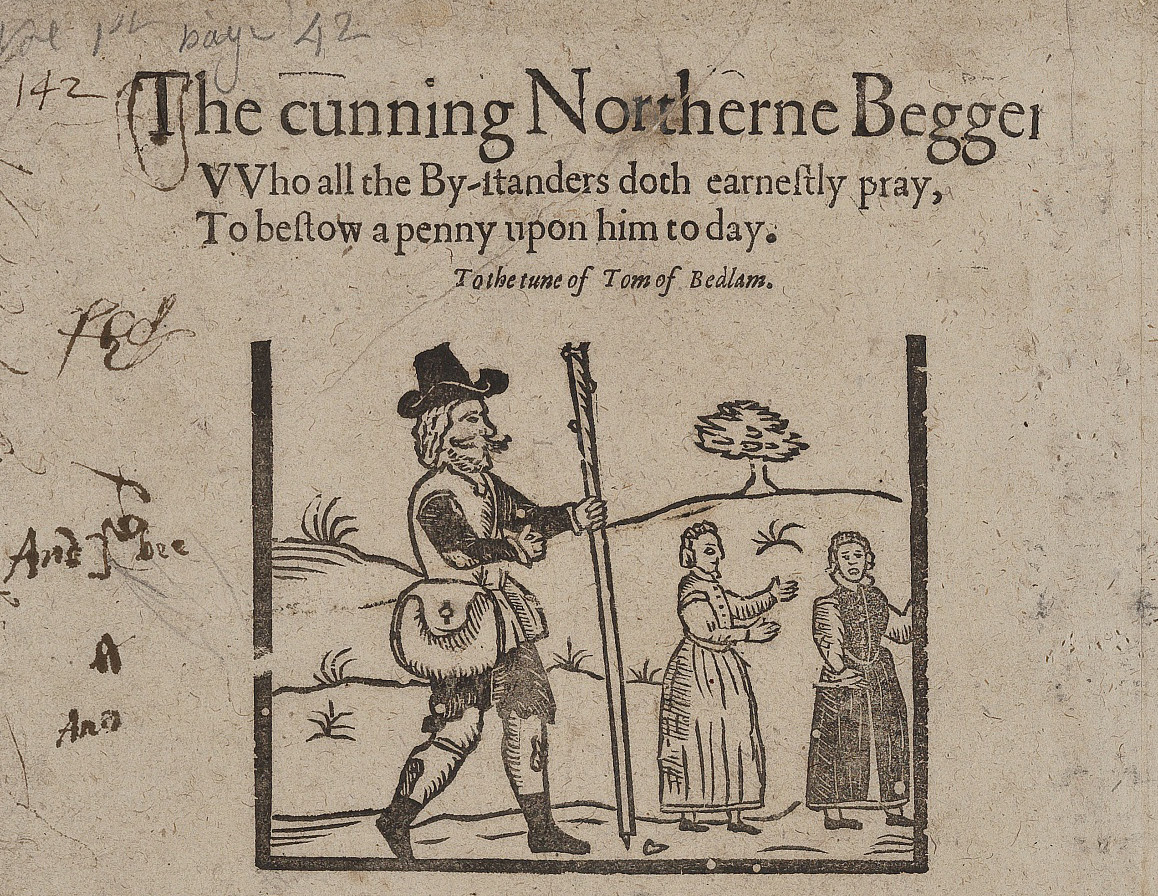In Shakespeare’s tragedy
King Lear, the King—betrayed by his daughters, bereft of his kingdom—sets off across the heath in a fit of rage. In a forlorn hovel, he encounters a curious character. Half-naked, his face “grimed with filth,” the man introduces himself as
Poor Tom; that eats the swimming frog, the toad, the tadpole, the wall-newt and the water; that in the fury of his heart, when the foul fiend rages, eats cow-dung for sallets; swallows the old rat and the ditch-dog; drinks the green mantle of the standing pool; who is whipped from tithing to tithing, and stock-punished, and imprisoned…. (
1)
Lear cannot know that Tom, with his wild appetites, hallucinations, and tales of persecution is, in fact, Edgar, son of the Earl of Gloucester. Falsely accused of plotting against his father, Edgar has also fled to the heath, disguised as a “Bedlam beggar.” The conversation that ensues between the two madmen—one feigned, one real— is one of the most dizzying and psychiatrically rich in a play famously brimming with madness in its many forms (
2).
Who then was this “Tom of Bedlam,” featured so prominently on the title page of the first quarto edition of the play? To begin, while Shakespeare may have been Tom’s most famous champion, Tom was not the Bard’s invention. Less a man, than many, Tom was a familiar folkloric “type” well known to 17th-century audiences: a “lunatick” vagabond who claimed to have been released from the notorious London asylum of St. Mary of Bethlehem (Bedlam).
“Claimed,” here, is key. For the earliest references to the figure of Tom are not as madmen but as malingering beggars. In other words, Edgar, rather than just playing a madman, was playing a man
playing a madman. First appearing in the printer John Awdeley’s 1561
Fraternitye of Vacabondes, a compendium of Elizabethan beggar types, “poor Tom” was described as one who “walketh bare armed, and bare legged, and faineth him selfe mad” (
3). Later “rogue encyclopedias” listed him among such deceptive vagabonds as “whipjackes” (fake shipwrecked sailors) and “priggers of prauncers” (horse thieves) (
4). By the 17th century Tom was familiar enough as to be recognizable by his “long staff, and a cow or ox-horn by his side; his cloathing fantastic and ridiculous... decked and dressed all over with robins [ribbons], feathers, cuttings of cloth” (
5).
No one knows how many flesh-and-blood Toms were wandering the countryside by the time Shakespeare cast him as Edgar’s disguise. But few could have come from the institution itself: Saint Mary of Bethlehem in those decades housed fewer than 30 patients at a time. And yet so many beggars claimed to have been released from Bedlam that in 1675 the overseers of the hospital placed an advertisement in the
London Gazette disclaiming the hoaxes (
6).
With the end of the Civil Wars, Tom of Bedlam was said to have disappeared from English highways (
7). By then, however, he had been immortalized, not only by Shakespeare, but in a proliferation of popular songs. There was “Loving Mad Tom” and “The Vagabond” and “To find my Tom of Bedlam.” Some became so famous that other songs could be published with the simple direction “to be sung to the tune of Tom of Bedlam” (
figure).
Of all the Mad Tom songs, one in particular stands out: “From the Hagg and Hungry Goblin,” an anonymous piece transcribed around 1615, now surviving in a single manuscript in the British Museum. In it we find Tom, recently released from Bedlam (or claiming so), begging for alms as he travels alone:
With a host of furious fancies Whereof I am commander, With a burning spear and a horse of air, To the wilderness I wander.
The song, quoted by Poe, Kipling, and Scott, was praised by the critic Harold Bloom for a “visionary perspective only rarely achieved in poetic history” (
8). The poet Sir Robert Graves even suggested it was written by Shakespeare himself (
9).
Or perhaps Tom never really vanished, but instead lives in those who have inherited his itinerancy. For, with this remarkable character, Shakespeare also created a mirror for today’s troubled wanderers, pursued by their own “foul fiends.” In them we find Tom’s many-layered complexity: at times seeking pity, at times refusing it, at times threatening, at times forlorn, at times arresting with their colorful clothes and speech. At times mad, at times playing madder: “knights,” as one Mad Tom put it, “of ghosts and shadows.”


